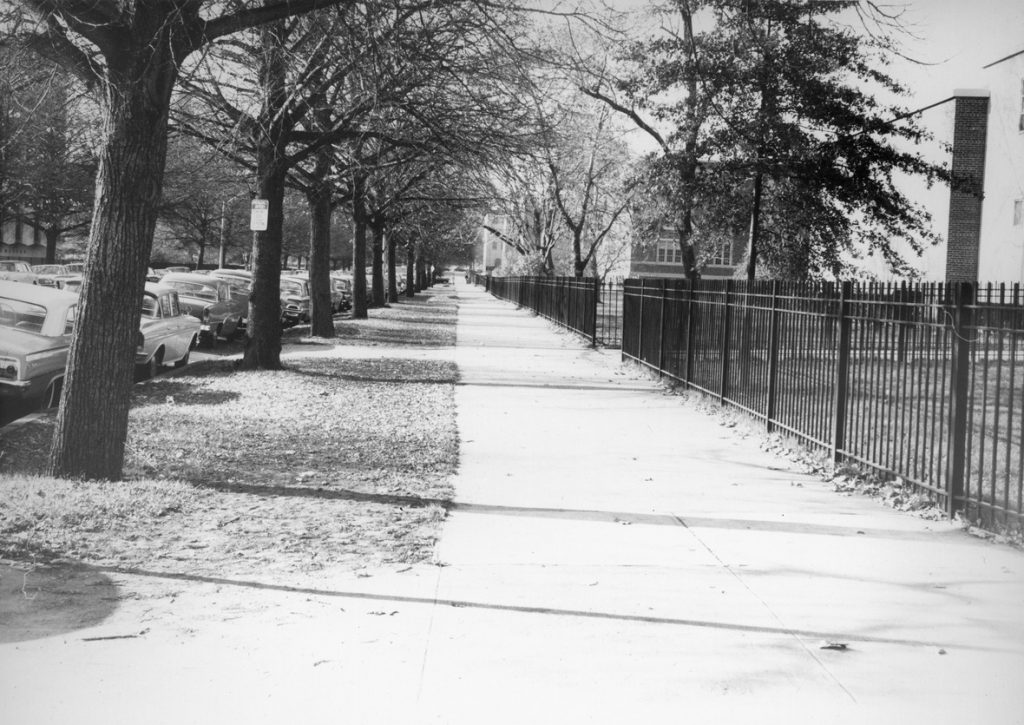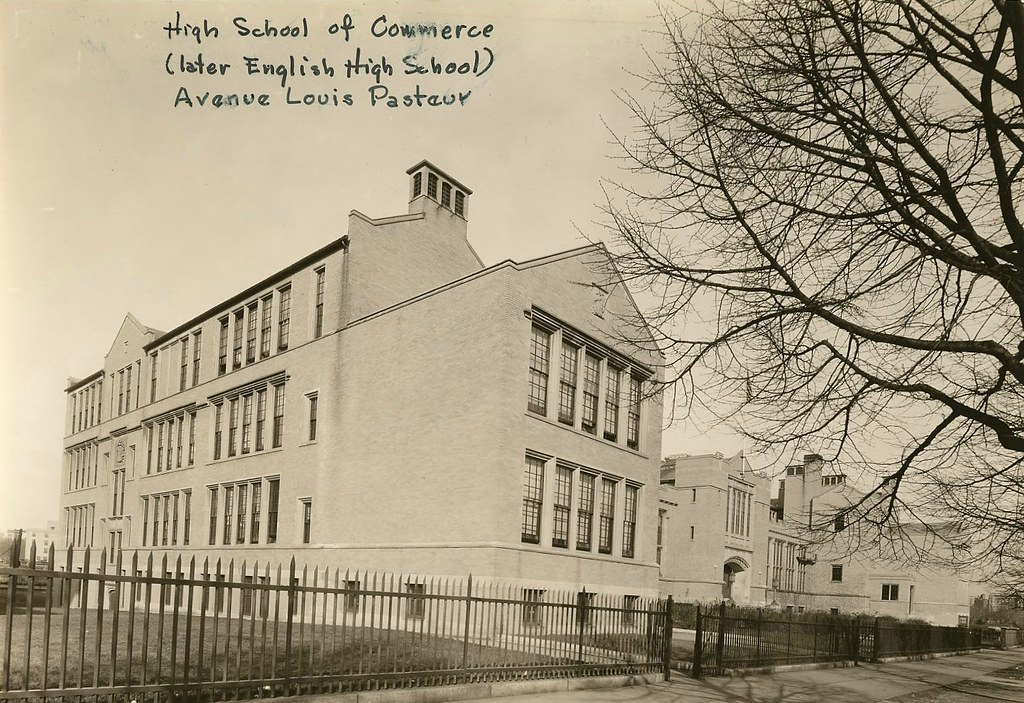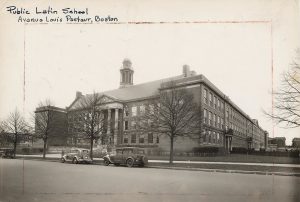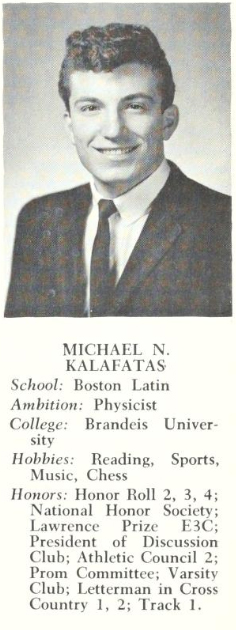English High School History
Remembering Avenue Louis Pasteur
English High alumnus Michael Kalafatas’ 61, shares the history and personal memories of “a place of inspiration that nurtured aspiration.”

Avenue Louis Pasteur (looking towards Longwood Ave. and Harvard Medical School), from the corner of The Fenway. Simmons College (Beatley Library) is on the left, and Emmanuel College is on the right.
“Avenue Louis Pasteur.” It just sounds smart, doesn’t it? And why wouldn’t it? Although a public avenue, it was named by the Harvard Medical School. Located in the Longwood area of Boston—near the Fens—it was built in 1906 at the request of the Harvard Medical School, which had relocated to Longwood Avenue in 1904. Harvard Medical School remains an iconic cluster of five white marble-faced buildings that sit atop Avenue Louis Pasteur. Wide and beautiful, the avenue itself is just 500 yards long and fully lined with trees and institutions of learning. In my time, in addition to Harvard Medical School, were Boston English High School, Boston Latin School, Emmanuel College, and Simmons College. Avenue Louis Pasteur as a name is a rarity in the world. The only other Avenue Louis Pasteur is located in Saigon, of all places, recalling Viet Nam’s troubled and trampled past as a colony in the French imperium.
The other end of Avenue Louis Pasteur meets The Fens and around that corner, a stroll away, are the Isabella Stewart Gardner Museum and the Boston Museum of Fine Arts—both filled with art treasures and integral to the Gardner experience live classical and operatic music.

English High School on Avenue Louis Pasteur

Boston Latin School on Avenue Louis Pasteur
In my time at English High School it was sited next to the Harvard Medical School residence hall and directly—exquisitely—across the street from Boston Latin School, the two historic rivals face to face on a tree-lined boulevard. Avenue Louis Pasteur was the creation of the brilliant landscape architect Frederick Law Olmsted, who designed Boston’s famed “Emerald Necklace” of green and open spaces, offering citizens relief and refreshment from the pressures and tensions of everyday life. Olmsted also designed New York’s Central Park, Brooklyn’s Prospect Park, the U.S. Capitol grounds, and the Biltmore Estate. In the Fens Olmsted found a disease-breeding Muddy River and swampland and transformed these into beloved Fens parkland and urban wild.
 I spent six years on Avenue Louis Pasteur—three at Boston Latin School and three at English High—distant in so many ways from the three-decker in South Boston where I was raised in a neighborhood bordering factories and warehouses, where the only people who went to college were all from my own family. From Avenue Louis Pasteur and English High School, I went off to Brandeis University, a graduate degree at Harvard, and then a return to Brandeis and a 35-year career in college admissions, a quarter century as Director of Admissions. It was a career I loved. I also had a writing side life that included three books. Decades after EHS I recall going out for coffee on Brookline Avenue with the President of Children’s Hospital, David Weiner, a BLS graduate and a Brandeis graduate, the two of us sipping coffee a stone’s throw from Avenue Louis Pasteur, which decades back had launched our professional lives.
I spent six years on Avenue Louis Pasteur—three at Boston Latin School and three at English High—distant in so many ways from the three-decker in South Boston where I was raised in a neighborhood bordering factories and warehouses, where the only people who went to college were all from my own family. From Avenue Louis Pasteur and English High School, I went off to Brandeis University, a graduate degree at Harvard, and then a return to Brandeis and a 35-year career in college admissions, a quarter century as Director of Admissions. It was a career I loved. I also had a writing side life that included three books. Decades after EHS I recall going out for coffee on Brookline Avenue with the President of Children’s Hospital, David Weiner, a BLS graduate and a Brandeis graduate, the two of us sipping coffee a stone’s throw from Avenue Louis Pasteur, which decades back had launched our professional lives.

Frank Ronan, ’59
By the way, quite sentimentally, I recall “running quarters” (quarter miles) on Avenue Louis Pasteur with Frank Ronan, two years my senior and the son of Cliff Ronan, the highly successful English High track coach and one of New England’s most revered track-and-field leaders. Frank went off to run and to compete in the pole vault at Bowdoin College. He majored in Latin and spent his 30-year career at IBM in its impressive heyday. Who says the Classics don’t prepare you for the world of high-technology?
Avenue Louis Pasteur was close enough to Fenway Park for me to regret, on September 28, 1960, in the fall of senior year, not skipping out on my last class on a gray overcast afternoon and in a fifteen-minute walk been at Fenway Park to sit in the half-filled grandstand and witness Ted Williams homer in his last at bat. That at bat would be immortalized by writer John Updike who, by pure chance, happened to be in the stands that day. His brilliant New Yorker piece, “Hub Fans Bid Kid Adieu” shines as one of the best pieces of sports writing ever, although written by a great writer of fiction. Now, all in all—Avenue Louis Pasteur—just how great a neighborhood is that?
